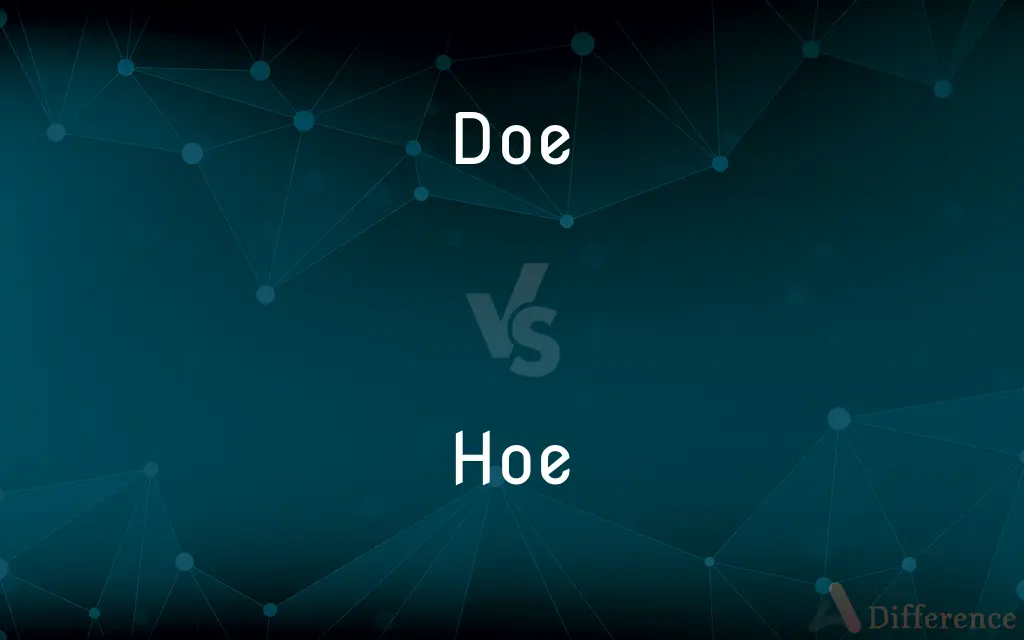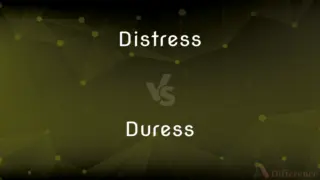Doe vs. Hoe — What's the Difference?
Edited by Tayyaba Rehman — By Urooj Arif — Updated on March 29, 2024
A doe is a female deer, while a hoe is a garden tool used for weeding and cultivating soil.

Difference Between Doe and Hoe
Table of Contents
ADVERTISEMENT
Key Differences
Doe refers to the female of various species of deer, known for their grace, agility, and the role they play in the ecosystem. Does are often characterized by their lack of antlers, which are typically found only on males (except in certain species like reindeer). On the other hand, a hoe is a hand tool used in gardening and farming, consisting of a long handle and a flat blade, which is used to shape soil, remove weeds, and prepare garden beds for planting.
While a doe is a living creature, part of wildlife and ecosystems around the world, contributing to the balance of nature and offering a subject of interest for wildlife watchers and hunters alike, a hoe is an inanimate object, essential in agriculture and gardening. The hoe is designed to assist in the cultivation of plants, allowing humans to control weeds, aerate the soil, and prepare land for seeding or planting.
The term "doe" connects more with discussions on wildlife management, ecology, and hunting regulations. It represents a component of natural biodiversity, with does playing a crucial role in the reproduction and maintenance of deer populations. In contrast, "hoe" relates to agricultural practices, gardening, cultivation techniques, and the human effort to produce food, flowers, and other plant-based resources.
In cultural and literary contexts, "doe" may symbolize gentleness, fertility, and the untamed beauty of nature. Meanwhile, the "hoe" is often emblematic of labor, cultivation, and the human relationship with the land, symbolizing the hard work involved in farming and gardening.
Understanding these terms highlights the difference between a natural entity and a man-made tool, each significant in their respective domains: wildlife and natural ecosystems for the doe, and agriculture and gardening for the hoe.
ADVERTISEMENT
Comparison Chart
Nature
A living animal, specifically a female deer.
A gardening tool used for soil cultivation.
Function
Reproduces and contributes to the ecosystem.
Cultivates soil, removes weeds, and prepares beds.
Context
Wildlife, ecology, and hunting.
Gardening, agriculture, and cultivation.
Characteristics
Lacks antlers (in most species) and is graceful.
Consists of a long handle and a flat blade.
Symbolism
Often represents gentleness and fertility.
Symbolizes labor and human interaction with the land.
Compare with Definitions
Doe
A female deer, often without antlers.
The doe grazed quietly in the meadow.
Hoe
Comes in various shapes for different tasks.
The stirrup hoe is effective for slicing through weeds.
Doe
Symbolic of gentleness in various cultures.
In literature, the doe is often a symbol of peaceful nature.
Hoe
A symbol of cultivation and hard work.
The hoe represents the gardener's effort in tending to their garden.
Doe
Central to deer population dynamics.
Wildlife management programs closely monitor doe populations.
Hoe
A tool for gardening and farming.
He used a hoe to prepare the vegetable garden for planting.
Doe
Can be a hunting term, referring to female game.
Hunting regulations may specify quotas for does.
Hoe
Essential for weed control without chemicals.
Organic farmers often rely on a hoe for weed management.
Doe
Varies in size and color across species.
The white-tailed doe is easily recognizable by her tail.
Hoe
Can be used to aerate soil.
Aerating the soil with a hoe helps water and nutrients reach plant roots.
Doe
A female deer, especially a female roe, fallow deer, or reindeer.
Hoe
A tool with a flat blade attached approximately at a right angle to a long handle, used for weeding, cultivating, and gardening.
Doe
A female deer.
Hoe
To weed, cultivate, or dig up with a hoe.
Doe
The female of various other mammals, such as antelopes, kangaroos, mice, or rabbits.
Hoe
To work with a hoe.
Doe
A female deer; also used of similar animals such as antelope, (less commonly goat as nanny is also used).
Hoe
An agricultural tool consisting of a long handle with a flat blade fixed perpendicular to it at the end, used for digging rows.
Doe
A female rabbit.
Hoe
Alternative spelling of ho.
Doe
A female hare.
Hoe
A piece of land that juts out towards the sea; a promontory.
Doe
A female squirrel.
Hoe
(ambitransitive) To cut, dig, scrape, turn, arrange, or clean, with this tool.
To hoe the earth in a garden
Every year, I hoe my garden for aeration.
I always take a shower after I hoe in my garden.
Doe
A female kangaroo.
Hoe
(transitive) To clear from weeds, or to loosen or arrange the earth about, with a hoe.
To hoe corn
Doe
A female deer or antelope; specifically, the female of the fallow deer, of which the male is called a buck. Also applied to the female of other animals, as the rabbit. See the Note under Buck.
Hoe
Alternative spelling of ho.
Doe
The federal department responsible for maintaining a national energy policy of the United States; created in 1977
Hoe
A tool chiefly for digging up weeds, and arranging the earth about plants in fields and gardens. It is made of a flat blade of iron or steel having an eye or tang by which it is attached to a wooden handle at an acute angle.
Doe
Mature female of mammals of which the male is called `buck'
Hoe
The horned or piked dogfish. See Dogfish.
Hoe
To cut, dig, scrape, turn, arrange, or clean, with a hoe; as, to hoe the earth in a garden; also, to clear from weeds, or to loosen or arrange the earth about, with a hoe; as, to hoe corn.
Hoe
To use a hoe; to labor with a hoe.
Hoe
A tool with a flat blade attached at right angles to a long handle
Hoe
Dig with a hoe;
He is hoeing the flower beds
Common Curiosities
Can the term "doe" refer to animals other than deer?
While "doe" is primarily used to describe female deer, it can also refer to the female of other species, such as rabbits, in certain contexts.
Why is a hoe important in gardening?
A hoe is important for removing weeds, aerating the soil, and preparing land for planting, which are crucial for plant health and growth.
What are some common types of hoes used in gardening?
Common types include the garden hoe, stirrup hoe, and Dutch hoe, each designed for specific tasks like weeding or soil preparation.
What is the primary difference between a doe and a hoe?
The primary difference is that a doe is a female deer, a living creature, whereas a hoe is a tool used for cultivating soil.
How does wildlife management impact doe populations?
Wildlife management aims to maintain balanced doe populations to ensure ecosystem health and prevent overpopulation or underpopulation.
Can observing does provide ecological insights?
Yes, observing doe behavior and populations can offer valuable insights into habitat health, predator-prey dynamics, and ecological balance.
How does one choose the right hoe for gardening?
The choice depends on the gardening task, soil type, and personal preference for handle length and blade shape.
Is there a hunting season specifically for does?
Yes, many regions have specific seasons or quotas for hunting does to manage deer populations effectively and sustainably.
What materials are hoes typically made from?
Hoes are usually made from metal for the blade and wood or plastic for the handle, designed for durability and effectiveness.
How do cultural representations of does and hoes differ?
Does are often depicted as symbols of nature and gentleness, while hoes represent human labor, cultivation, and agriculture.
Share Your Discovery

Previous Comparison
Distress vs. Duress
Next Comparison
Face vs. DealAuthor Spotlight
Written by
Urooj ArifUrooj is a skilled content writer at Ask Difference, known for her exceptional ability to simplify complex topics into engaging and informative content. With a passion for research and a flair for clear, concise writing, she consistently delivers articles that resonate with our diverse audience.
Edited by
Tayyaba RehmanTayyaba Rehman is a distinguished writer, currently serving as a primary contributor to askdifference.com. As a researcher in semantics and etymology, Tayyaba's passion for the complexity of languages and their distinctions has found a perfect home on the platform. Tayyaba delves into the intricacies of language, distinguishing between commonly confused words and phrases, thereby providing clarity for readers worldwide.














































